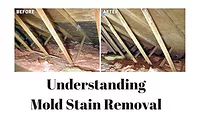A Breakthrough in Mold Stain Remover Technology

While there are a number of mold stain remover products on the market today, there are only three main technologies: hydrogen peroxides, bleach-based (Sodium Hypochlorite) and one new and unique one that employs peracetic acid. Each technology has its pros and cons but at the end of the day, hydrogen peroxide just doesn’t have the power to completely remove tough stains, bleach does but is corrosive and harsh, but peracetic acid has all the power without the dangers.
Importance of Mold Stain Removal
Why is removing mold stains such a big deal? Put simply, “pre-loss condition” does not include mold stains. Mold growth and the mold staining that results devalues property and causes problems for property owners. Remember however, removing or improving the appearance of mold staining is NOT mold remediation (i.e. the physical removal of mold contaminants). Even so, it’s an important part of mitigating the damage caused by mold growth.
Until recently the only widely known way to remove mold staining was to remove a layer of the surface of wood materials via sanding or media blasting… or by covering the stained surface with an opaque coating. New technologies, such as Concrobium Mold Stain Remover, now make it possible to safely remove the mold staining without damaging or covering up the structural materials.
What is Mold Staining?
So what is “mold staining?” Without getting too technical, it is the visible result of fungal metabolic processes. In other words, it is visible staining on surfaces due to mold digestion. When you consider that there are thousands of types of mold species, digesting thousands of different types of potential food sources (usually cellulose, but often combined with various environmental contaminants)… in hundreds of types of environmental conditions on hundreds of different types of surfaces… you might get the idea that no two mold staining situations are alike.
This is important to remember: it is difficult if not impossible to predict the results of mold stain removal. For example, there are cases where the mold has been digesting the surface of the wood in an attic for many years. In those cases there is no way to make the surfaces look new again without removing a significant layer of the surface (which reduces the materials’ structural integrity). There are also situations where the mold has trapped soot or some type of inorganic pollutants that cause stains that do not react with Mold Stain Removers.
With that in mind, the difficulty of removing mold stains falls on a spectrum of difficulty ranging in mold stains that can be just wiped off to those that are impossible to remove.
The recently reformulated Concrobium Mold Stain Remover harnesses the unique benefits of peracetic acid-based one to provide both maximum power and maximum non-corrosive safety. While peracetic acid is the unique active ingredient, the product’s effectiveness actually relies on the synergy of several ingredients that work together to eliminate the toughest of old mold stains. The new formulation is:
- all-liquid
- ready to use instantly
- can be applied with a foaming sprayer (or any sprayer for that matter),
- safer than the competition
Concrobium Mold Stain Remover is also the most economical product on a per square foot cost basis and is currently the only product that is able to remove the toughest mold stains… but without the hazards and liability found in bleach-based products. For a product that is not corrosive, has a much lighter scent that dissipates quickly, leaves no hazardous chemistry behind, is more economical, and is much safer to handle and apply…Concrobium Mold Stain Remover is clearly the best choice in today’s market.
Looking for a reprint of this article?
From high-res PDFs to custom plaques, order your copy today!




